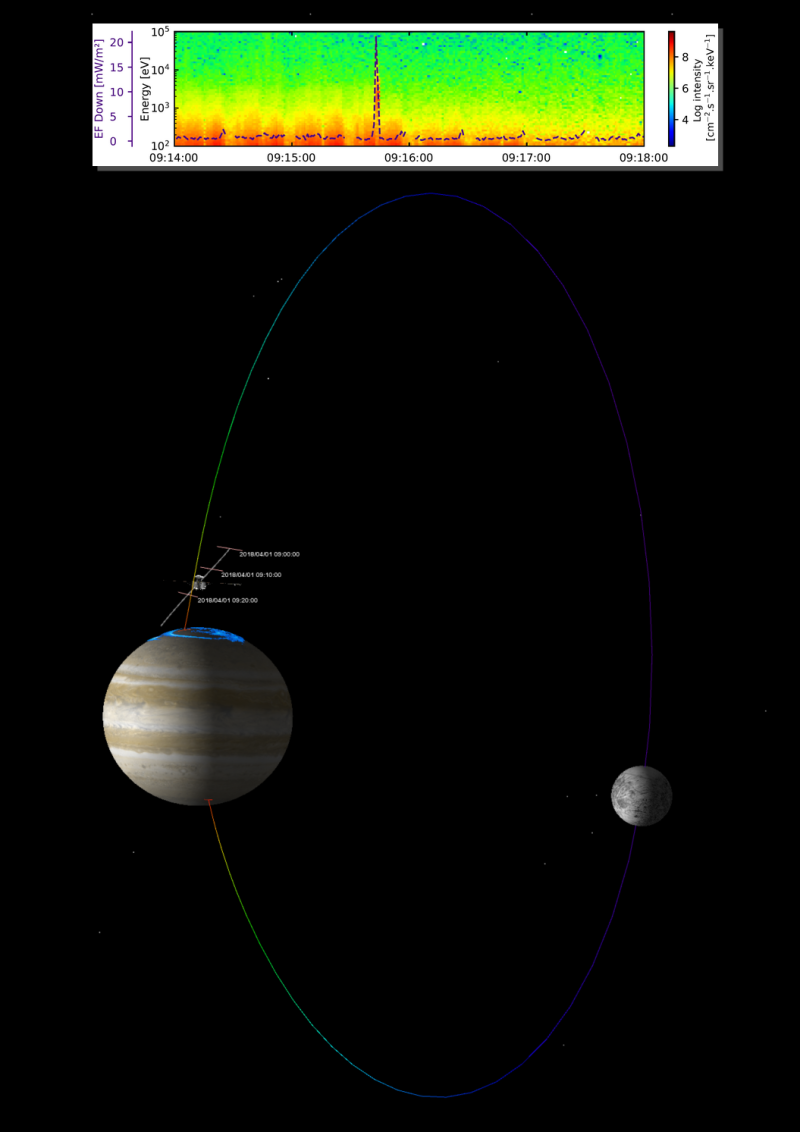Towards a better understanding of moon-magnetosphere plasma interactions in the Jupiter system?
Jupiter’s vast magnetosphere is filled with a plasma of electrons and ions, mainly produced by the intense volcanic activity of the moon Io. Driven into rapid rotation by Jupiter’s intense magnetic field, the particles organize themselves into an extended plasma disk, commonly referred to as a magnetodisk. Jupiter’s four largest moons, Io, Europa, Ganymede and Callisto, move in this disk within Jupiter’s magnetosphere, and are constantly caught up in the plasma, which orbits much faster than they do. They thus disrupt the plasma flow. Electromagnetic waves are generated in their close environment: propagating along magnetic field lines, these waves can accelerate electrons. Some of these then precipitate into Jupiter’s atmosphere, producing characteristic auroral structures known as “footprints”, visible in both the ultraviolet and infrared. These moon-induced auroral emissions generally consist of a main, brighter spot, followed by an auroral tail whose brightness gradually fades.
The Juno mission, which completed its 50th orbit in April 2023, is equipped with state-of-the-art plasma instrumentation to study the behavior of charged particles in Jupiter’s magnetosphere. Thanks to its unique polar orbit, the satellite can carry out plasma measurements above Jupiter’s poles, but also close to the moons’ orbits.
In a recent paper, a team of scientists attached to CNRS-INSU studied the properties of electrons accelerated by the interaction between the moon Europa and Jupiter’s magnetosphere. By analyzing data collected over the last six years by the JADE-E (Jupiter Auroral Distribution Experiment) instrument (1) , they have shown for the first time that the properties of electrons change with distance from the moon, in particular their energy distribution. They also demonstrated a decrease in the energy flux generated by the electrons as a function of distance from Europa, compatible with the evolution of the brightness of the auroral tail associated with the moon.
These observations reveal the underlying processes of particle acceleration, which are still poorly understood. They also pave the way for comparative studies between Galilean moons, notably with Io, whose interactions with Jupiter’s magnetosphere remain, for the time being, the best documented.

Note :
- IRAP has built the electrostatic optics for speed and energy selection of low-energy electrons.
Further Resources
- Scientific article : Rabia, J., Hue, V., Szalay, J. R., André, N., Nénon, Q., Blanc, M., et al. (2023). Evidence for non-monotonic and broadband electron distributions in the Europa footprint tail revealed by Juno in situ measurements. Geophysical Research Letter.
- Communiqué de Presse du CNRS-INSU
IRAP Contacts
- Jonas Rabia, jonas.rabia@irap.omp.eu
- Nicolas André, nicolas.andre@irap.omp.eu
- Quentin Nénon, quentin.nenon@irap.omp.eu






